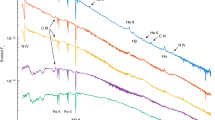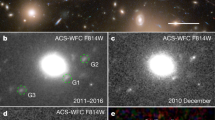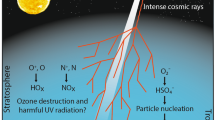Abstract
A NUMBER of suggestions have been made1–3 that encounters of the solar system with extra-solar phenomena in earlier epochs led to climatic and biological catastrophes. Most recently Whitten et al.4 and Clark et al.5 have drawn attention to the role of nearby supernovae (within ≃ 10 pc) from which catastrophic effects are expected (primarily the depletion of the atmospheric ozone layer and consequent transmission of damaging solar ultraviolet.) Whitten et al. estimate the probability of an encounter within a period of 108 yr to be 1–5% and Clark et al. calculate 50% for the same quantity. In this letter, we argue that it is likely that rare and very big solar flares, and their attendant cosmic-ray fluxes, will give even more dramatic effects. This idea is not new, in that Reid et al.6 have drawn attention to the effect of solar flares on the evolution of life, but here we endeavour to estimate the likely frequency of solar flares of sufficient strength to have significant effects. Furthermore, we draw attention to the ‘explosion’ at the galactic centre postulated by some7 to have occurred about 107 yr ago; if this actually took place then its effect too would have been important and exceeded likely supernova phenomena.
This is a preview of subscription content, access via your institution
Access options
Subscribe to this journal
Receive 51 print issues and online access
$199.00 per year
only $3.90 per issue
Buy this article
- Purchase on SpringerLink
- Instant access to full article PDF
Prices may be subject to local taxes which are calculated during checkout
Similar content being viewed by others
References
Shapley, H. Sky Telescope 9, 36 (1949).
Shapley, J. J. Geol. 29, 502 (1921).
Hoyle, F. & Lyttleton, R. A. Proc. Camb. Phil. Soc. 35, 405 (1939).
Whitten, R. C., Cuzzi, J., Borucki, W. J. & Wolfe, J. K. Nature 263, 398 (1976).
Clark, D. H., McCrea, W. H. & Stephenson, F. R. Nature 265, 318 (1977).
Reid, G. C., Isaksen, I. S. A., Holzer, T. E. & Crutzen, P. J. Nature 259, 177 (1976).
Saunders, R. H. & Prendergast, K. H. Astrophys J. 188, 489 (1974).
Chupp, E. L. & Williams, R. W. J. Phys. Soc. Japan 2, 281 (1962).
McDonald, F. B., Fichtel, C. E. & Fisk, E. A. High Energy Particles and Quanta in Astrophysics 212 (M.I.T., Massachusetts, 1974).
Crutzen, P. J., Isaksen, I. S. A. & Reid, A. C. Science 189, 457 (1975).
Allen, C. W. 1973, Astrophysical Quantities (Athlone, London, 1973).
Schove, D. J. J. geophys. R. 60, 2 (1955).
Dorman, L. I. Prog. in Elem. Particles and Cosmic Ray Physics (North-Holland, Amsterdam, 1963).
Lovell, A. C. B. Phil. Trans. 277, 489 (1975).
Shaeffer, O. A. Proc. 14th Int. Cosmic Ray Conf. Munich 11, 3508 (1975).
Dergachev, V. A. & Malchenko, N. I. Proc. All-Union Conf. Astrophysical Phenomena and Radiocarbon Tbilisi 73 (1974).
Kocharov, G. E., Dergachev, V. A. & Gordeichik, N. J. Proc. 14th Int. Cosmic Ray Conf. Munich 3, 18 (1975).
Colgate, S. Astrophys. J. 187, 333 (1974).
Author information
Authors and Affiliations
Rights and permissions
About this article
Cite this article
WDOWCZYK, J., WOLFENDALE, A. Cosmic rays and and ancient catastrophes. Nature 268, 510–512 (1977). https://doi.org/10.1038/268510a0
Received:
Accepted:
Issue date:
DOI: https://doi.org/10.1038/268510a0
This article is cited by
-
Long Term Time Variability of Cosmic Rays and Possible Relevance to the Development of Life on Earth
Surveys in Geophysics (2010)
-
Heliospheric magnetic fields, energetic particles, and the solar cycle
Journal of Astrophysics and Astronomy (2000)
-
Thermal neutrons could be a cause of biological extinctions 65 Myr ago
Nature (1983)



